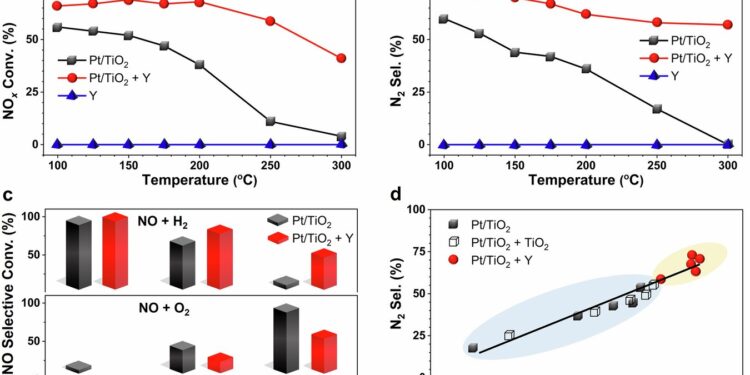Effect of physical mixture Pt/TiO2 with zeolite Y on the H2-SCR performance. A NOx conversion, and (b)N2 selectivity in H2-SCR reaction; c NO selective conversion (that’s to say., NOT reacting with H2 or O2) in H2-SCR reaction on Pt/TiO2 and Pt/TiO2 + Y catalysts (see the Methods section for a detailed calculation); d Correlation between N2selectivity and NOx conversion to H2-SCR reaction on Pt/TiO2Pt/TiO2 + TiO2 and Pt/TiO2+ Y catalysts. Reaction conditions: 26 mg Pt/TiO2catalyst, or a physical mixture containing 26 mg of Pt/TiO2and 26 mg of Y or TiO2; steady-state testing; 500 ppm NO, 1% H210% O25% CO2and 5%H2Oh; weight hourly space velocity (WHSV) = 461,540 mL·gPt/TiO2–1·h–1. Credit: Natural communications (2024). DOI: 10.1038/s41467-024-52382-7
Hydrogen internal combustion engines hold great promise in the fight against climate change because they are powerful without emitting carbon that could warm the planet. They can power heavy-duty trucks and buses and are suitable for off-road and agricultural equipment as well as emergency power generators, providing cleaner alternatives to diesel engines.
However, they are not entirely clean. They emit nitrogen oxides during the combustion process at high temperatures. Nitrogen oxides react with other compounds in the atmosphere to form harmful ozone and fine particulate matter, which aggravate our lungs and lead to long-term health problems.
Fortunately, UC Riverside scientists have discovered an inexpensive method to significantly reduce this pollution from hydrogen engines by improving the efficiency of their catalytic converters.
As reported in the newspaper Natural communicationsResearchers have found that infusing platinum into catalytic converters with a highly porous material called Y zeolites significantly enhances reactions between nitrogen oxides and hydrogen, converting them into harmless nitrogen gas and water vapor.
Compared to a catalytic converter without zeolites, the amount of nitrogen oxides converted into harmless substances increases four to five times at an engine temperature of 250 degrees Celsius, according to the study. The system has proven particularly effective at lower temperatures, which is crucial for reducing pollution when engines first start and are still relatively cold.
Additionally, the technology can also reduce pollution caused by diesel engines equipped with hydrogen injection systems, explained Fudong Liu, corresponding author and associate professor of chemical and environmental engineering at UCR’s Bourns College of Engineering. Hydrogen injection would be similar to injection systems used in selective catalytic reduction systems in large diesel trucks.
Zeolites are inexpensive materials with a well-defined crystal structure composed primarily of silicon, aluminum, and oxygen atoms. Their large surface area and three-dimensional cage-like structure composed of uniform pores and channels allow for more efficient decomposition of pollutants.
By physically mixing platinum with zeolite Y, a synthetic type from the broader family of zeolite compounds, the researchers created a system that effectively captures water generated during the hydrogen combustion process. This water-rich environment promotes hydrogen activation, essential for improving nitrogen reduction efficiency.
Shaohua Xie, a researcher at UCR and lead author of the study, explained that zeolite itself is not a catalyst. Instead, it improves the effectiveness of the platinum catalyst by creating a water-rich environment. Liping Liu, a Ph.D. student and Hongliang Xin, associate professor at Virginia Tech, then validated this concept through theoretical modeling of the new catalyst system.
“This concept can also be applied to other types of zeolites,” Xie added. “It’s a universal strategy.”
Liu pointed out that the method of reducing pollution is relatively simple.
“We don’t need to use complicated chemical or physical processes,” Liu said. “We simply mix the two materials – platinum and zeolite – together, run the reaction, and then see the improvement in activity and selectivity.”
Liu, Xie and Kailong Ye of UCR mixed platinum and zeolite Y powders and provided them to collaborating scientist Yuejin Li of BASF Environmental Catalyst and Metal Solutions (ECMS) in Iselin, New Jersey. The powder was made into a thick liquid slurry with binding compounds and applied to the honeycomb structures inside prototype catalytic converters. Scientists from the National Synchrotron Light Source II, or NSLS-II, at Brookhaven National Laboratory in Upton, New York, also collaborated.
More information:
Shaohua Xie et al, Zeolite-promoted platinum catalyst for efficient reduction of nitrogen oxides with hydrogen, Natural communications (2024). DOI: 10.1038/s41467-024-52382-7
Provided by University of California – Riverside
Quote: Scientists improve catalytic converter efficiency to reduce harmful pollution from hydrogen engines (2024, October 10) retrieved October 10, 2024 from
This document is subject to copyright. Except for fair use for private study or research purposes, no part may be reproduced without written permission. The content is provided for informational purposes only.



